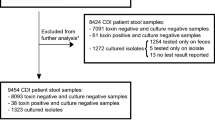Abstract
Nine hundred forty-five stool specimens from patients suspected of havingClostridium difficile disease were examined using a cell culture cytotoxicity assay (CTA), two enzyme immunoassay (EIA) kits (Cytoclone for toxins A and B; VIDAS for toxin A) and a latex agglutination assay (CDT). One hundred nineteen specimens had positive titers (≥90) in the CTA; clinical review of 16 discordant samples and 49 controls supported the significance of 90 as the positive cut-off titer. The performance of the two EIAs and the latex assay was assessed relative to CTA titers of the samples. Sensitivity was ≤ 50 % for all three assays for the 24 specimens with CTA titers of 90, but it reached 97–100 % for the two EIAs and 84 % for the latex assay at titers of ≥ 2,250. The Cytoclone EIA exhibited higher sensitivity at the lower positive titers. Overall, specificity of the methods ranged from 96.7 % (CDT latex assay) to 99.1 % (Cytoclone EIA).
Similar content being viewed by others
References
Bartlett JG: Antibiotic-associated diarrhea. Clinical Infectious Diseases 1992, 15: 573–581.
Borriello SP, Davies HA, Kamiya S, Reed PJ, Seddon S: Virulence factors ofClostridium difficile. Reviews of Infectious Diseases 1990, 12, Supplement 2: 185–191.
Lyerly DM, Krivian HC, Wilkins TD:Clostridium difficile: its disease and toxins. Clinical Microbiology Reviews 1988, 1: 1–18.
Marler LM, Siders JA, Wolters LC, Pettigrew Y, Skitt BL, Allen SD: Comparison of five cultural procedures for isolation ofClostridium difficile from stools. Journal of Clinical Microbiology 1992, 30: 514–516.
Peterson LR, Holter JJ, Shanholtzer CJ, Garrett CR, Gerding DN: Detection ofClostridium difficile toxins A (enterotoxin) and B (cytotoxin) in clinical specimens: evaluation of a latex agglutination test. American Journal of Clinical Pathology 1986, 86: 208–211.
Lyerly DM, Barroso LA, Wilkins TD: Identification of the latex test-reactive protein ofClostridium difficile as glutamate dehydrogenase. Journal of Clinical Microbiology 1991, 29: 2639–2642.
Kelly WF, Wait KJ, Gilligan PH: Evaluation of the latex agglutination test for detection ofClostridium difficile. Archives of Pathology and Laboratory Medicine 1992, 116: 517–520.
Borriello SP, Barclay FE, Reed PJ, Welch AR, Brown JD, Burdon DW: Analysis of latex agglutination test forClostridium difficile toxin A (D-1) and differentiation betweenClostridium difficile toxins A and B and latex reactive protein. Journal of Clinical Pathology 1987, 40: 573–580.
Doern GV, Coughlin RT, Wu L: Laboratory diagnosis ofClostridium difficile-associated gastrointestinal disease: comparison of a monoclonal antibody enzyme immunoassay for toxins A and B with a monoclonal antibody enzyme immunoassay for toxin A only and two cytotoxicity assays. Journal of Clinical Microbiology 1992, 30: 2042–2046.
Shanholtzer CJ, Willard KE, Holter JJ, Olson MM, Gerding DN, Peterson LR: Comparison of the VIDASClostridium difficile toxin A immunoassay withClostridium difficile culture and cytotoxin and latex tests. Journal of Clinical Microbiology 1992, 30: 1837–1840.
DeGirolami PC, Hanff PA, Eichelberger K, Longhi L, Teresa H, Pratt J, Cheng A, Letourneau JM, Thorne GM: Multicenter evaluation of a new enzyme immunoassay for detection ofClostridium difficile enterotoxin A. Journal of Clinical Microbiology 1992, 30: 1085–1088.
DiPersio JR, Varga FJ, Conwell DL, Kraft JA, Kozak KJ, Willis DH: Development of a rapid enzyme immunoassay forClostridium difficile toxin A and its use in the diagnosis ofClostridium difficile-associated disease. Journal of Clinical Microbiology 1991, 29: 2724–2730.
Lyerly DM, Sullivan NM, Wilkins TD: Enzyme-linked immunosorbent assay forClostridium difficile toxin A. Journal of Clinical Microbiology 1983, 17: 72–78.
Peterson LR, Olson MM, Shanholtzer CJ, Gerding DN: Results of a prospective, 18-month clinical evaluation of culture, cytotoxin testing, and culturette brand (CDT) latex testing in the diagnosis ofClostridium difficile-associated diarrhea. Diagnostic Microbiology and Infectious Disease 1988, 100: 85–91.
Borriello SP, Vale T, Brazier JS Hyde S, Chippeck E: Evaluation of a commercial enzyme immunoassay kit for the detection ofClostridium difficile toxin A. European Journal of Clinical Microbiology and Infectious Disease S 1992, 11: 360–363.
Author information
Authors and Affiliations
Rights and permissions
About this article
Cite this article
Mattia, A.R., Doern, G.V., Clark, J. et al. Comparison of four methods in the diagnosis ofClostridium difficile disease. Eur. J. Clin. Microbiol. Infect. Dis. 12, 882–886 (1993). https://doi.org/10.1007/BF02000416
Issue Date:
DOI: https://doi.org/10.1007/BF02000416




